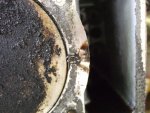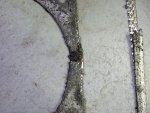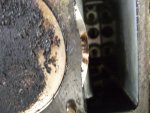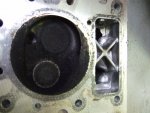mr.farmall
Active Member
- Joined
- Mar 13, 2014
- Threads
- 12
- Messages
- 65
16.5 hp single cylinder vertical OHV 3100 series Briggs & stratton on a Husqvarna zero turn mower. 31E877 1502-G1
The engine is burning a lot of oil, about 1/4 cup every 2 hours. No oil leaks. The plug is continually fouled, and is cleaned often. It has run ok in the past, but now it is starting to miss-fire and it has to be hard on the engine and fly wheel, with a big 3 inch piston and having a large and heavy flywheel When it miss-fires and then pops it creates quite a strain on the whole system, sounds like it is going to break the flywheel loose. (it does require a steel key in the flywheel.)
I have checked the flywheel key and the timing, it looks good. The carburetor has been cleaned. The fuel pump is working and the fuel shut off solenoid is work correctly.
The compression is about 90 psi. I got a leak down tester and it shows 40% leakage on the gauge. I hear no air noises in the carburetor intake nor the exhaust, but I do hear a substantial air hissing through the oil filler hole.
The engine has been serviced a lot. This engine runs fine for a while then begins to running poorly and has needed work since the beginning, more work than all of the other equipment all put together. It's only 4 years old. I'm very disappointed with it.
What I could use your advice and expertise with is the following;
1. Should this engine just be replaced with something like a twin cylinder about the same size?
2. What kind of problems would that create, mounting, electrical, fuel, etc.?
3. Should I try to replace the ring set? If the cylinder walls look good.
4. Could the miss-fire be from one of the safety switches, like the seat, going bad? and if so , how would you test for it?
Thanks for any help.
The engine is burning a lot of oil, about 1/4 cup every 2 hours. No oil leaks. The plug is continually fouled, and is cleaned often. It has run ok in the past, but now it is starting to miss-fire and it has to be hard on the engine and fly wheel, with a big 3 inch piston and having a large and heavy flywheel When it miss-fires and then pops it creates quite a strain on the whole system, sounds like it is going to break the flywheel loose. (it does require a steel key in the flywheel.)
I have checked the flywheel key and the timing, it looks good. The carburetor has been cleaned. The fuel pump is working and the fuel shut off solenoid is work correctly.
The compression is about 90 psi. I got a leak down tester and it shows 40% leakage on the gauge. I hear no air noises in the carburetor intake nor the exhaust, but I do hear a substantial air hissing through the oil filler hole.
The engine has been serviced a lot. This engine runs fine for a while then begins to running poorly and has needed work since the beginning, more work than all of the other equipment all put together. It's only 4 years old. I'm very disappointed with it.
What I could use your advice and expertise with is the following;
1. Should this engine just be replaced with something like a twin cylinder about the same size?
2. What kind of problems would that create, mounting, electrical, fuel, etc.?
3. Should I try to replace the ring set? If the cylinder walls look good.
4. Could the miss-fire be from one of the safety switches, like the seat, going bad? and if so , how would you test for it?
Thanks for any help.




